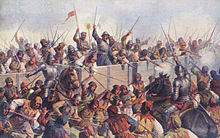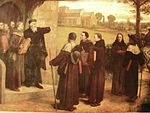Taborites
This article includes a list of general references, but it lacks sufficient corresponding inline citations. (September 2008) |


The Taborites (Czech: Táborité, Czech: singular Táborita), known by their enemies as the Picards,[1][why?] were a faction within the Hussite movement in the medieval Lands of the Bohemian Crown.
Although most of the Taborites were of rural origin, they played a major role in the town of
Overview

The Taborites were centered in the
The Taborites' theology represented a departure from that of the medieval Catholic Church. They insisted on the normativeness of biblical authority. Even though Taborite theologians were versed in scholastic theology, they rejected scholastic methods.
History
In the spring of 1420, a group of

Hussites from
At the end of August, Jan Žižka launched a large offensive against the estate of Oldřich of Rosenberg. The governor seized Prachatice, Vodňany and Lomnice. Young Oldřich was forced to conclude a ceasefire with Tábor until February 1421. Mikuláš of Pelhřimov was elected bishop of Tábor in September 1420. In December, Hetman Nicholas of Hus died as a result of a fall from a horse. The leader of the Taborites was now the governor Jan Žižka of Trocnov.


Jan Žižka commanded his rag-tag

Once the external threat was removed by Hussite victories, the various Hussite factions turned on each other. At the beginning of 1421, the Adamites, who completely rejected the

After Jan Žižka's death on 11 October 1424, Jan Hvězda of Vícemilice and Bohuslav of Švamberk took the lead of the Taborite forces. The combined forces of Taborites,
After the Battle of Lipany, the opposition to King Sigismund and the agreement with the Council was led by governor Jan Roháč of Dubá. However, after the Taborites lost several of their castles and were defeated on 19 August 1435 by Oldřich of Rožmberk in the Battle of Křeč, the moderate wing, led by Bedřich of Strážnice, took over the Táborite faction. Jan Roháč and his faithful fortified at his castle Zion, which was soon conquered and all the surviving defenders were hanged in the Old Town Square of Prague. On 25 January 1437, by mutual agreement with Sigismund, Tábor was promoted to royal town and received the town's coat of arms: an imperial eagle. On 8 February 1449, the remnants of the Taborite union were joined with the Catholic and Kališník nobility from South Bohemia, and so the so-called Strakonice Unity was established, which was directed against the ever-growing power of George of Poděbrady. On 1 September 1452, the town of Tábor was suddenly occupied by the army of the land administrator George of Poděbrady, and thus the independent political power of the Tábor union was ended.
See also
References
- ^ Gieseler, Johann Karl Ludwig (1858). A Text-book of Church History. Vol. 3. Harper & brothers. p. 439.
- ISBN 9780761925989. Retrieved 13 November 2016.
- ^ Moran, Sean (1991). "Patrick Pearse and Patriotic Soteriology: The Irish Republican Tradition and the Sanctification of Political Self-Immolation". The Irish Terrorism Experience.
- ^ Bookchin, Murray. The Ecology of Freedom: The Emergence and Dissolution of Hierarchy. pp. 207–208.
- ISBN 978-1-59244631-5, p. 427
- ISBN 978-0-81087365-0, p. 21
- ^ Norman Cohn (2011),
The Pursuit of the Millennium, Random House, ISBN 978-1-44810394-2, p. 220
Further reading
- The Hussite Wars (1419–36), Stephen Turnbull, ISBN 1-84176-665-8)
- The Pursuit of the Millennium, Norman Cohn, Pimlico 1993 (new ed.) (ISBN 978-0712656641)
External links
- Joan of Arc's Letter to the Hussites (23 March 1430) – In 1430, Joan of Arc dictated a letter threatening to lead a crusading army against the Hussites unless they returned to "the Catholic Faith and the original Light". This link contains a translation of the letter plus notes and commentary.
- The Hussite Wars
- The Bohemian War (1420–1434)


